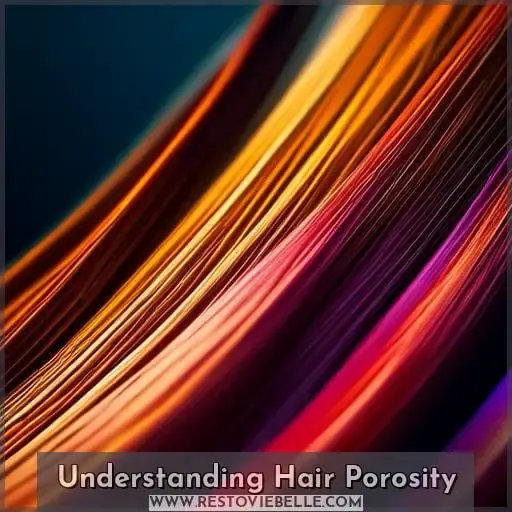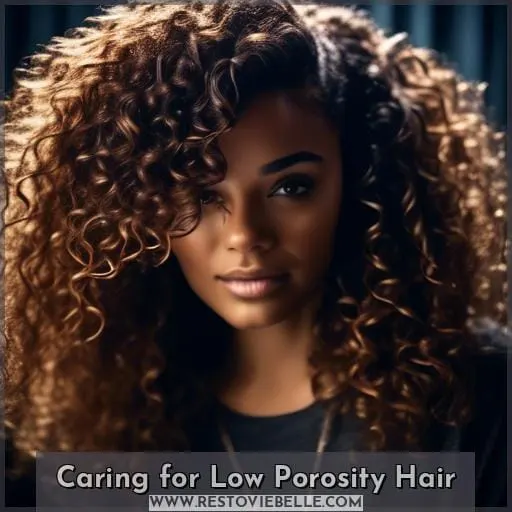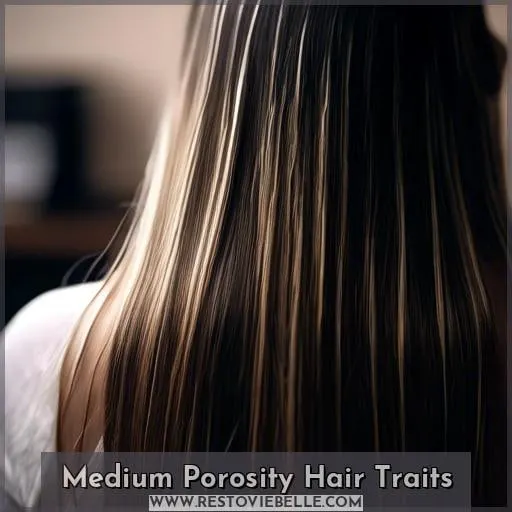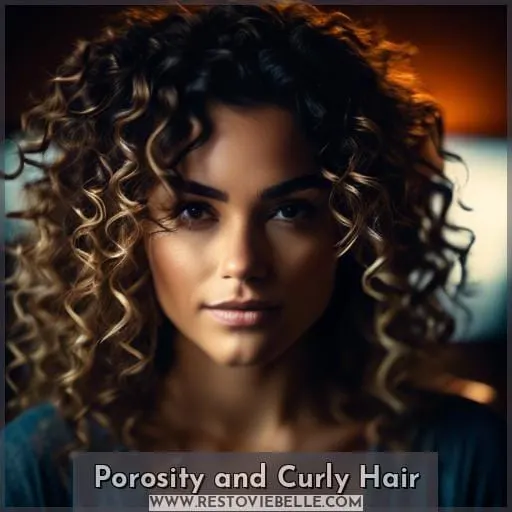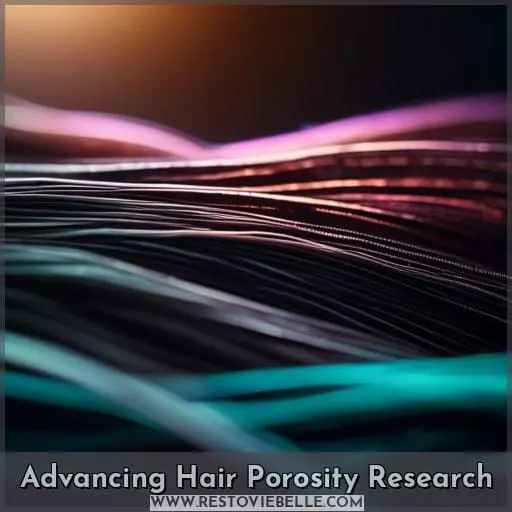This site is supported by our readers. We may earn a commission, at no cost to you, if you purchase through links.
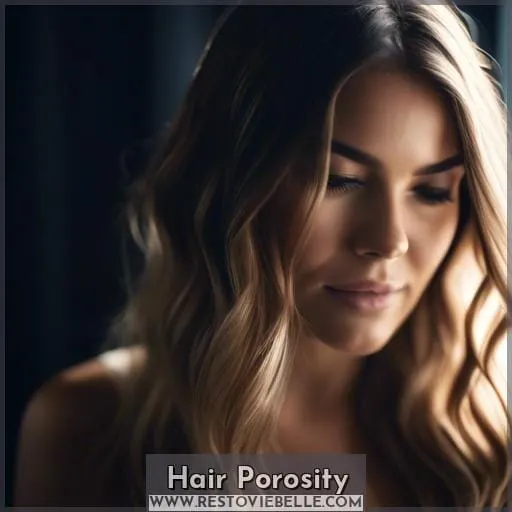
Hair porosity, essentially your hair’s ability to soak up and hold onto water, is influenced by the condition of your hair’s cuticle.
Whether you’re battling with moisture retention, trying to avoid product buildup, or seeking the perfect hydration balance, understanding your hair’s porosity is key.
This guide delves into identifying your hair porosity type—be it low, medium, or high—and tailors care strategies to ensure your hair not only looks its best but feels it too.
Embrace this journey to unlock the secrets of your hair’s unique needs and characteristics.
Table Of Contents
- Key Takeaways
- Understanding Hair Porosity
- Identifying Porosity Levels
- Low Porosity Characteristics
- Caring for Low Porosity Hair
- Medium Porosity Hair Traits
- High Porosity Hair Challenges
- Managing High Porosity Hair
- Porosity and Curly Hair
- Advancing Hair Porosity Research
- Frequently Asked Questions (FAQs)
- How does hair porosity affect the use of hair dyes and color treatments?
- Can seasonal changes impact hair porosity, and if so, how?
- What is the relationship between hair porosity and scalp health?
- How does hair porosity influence the effectiveness of natural home remedies for hair care?
- Are there any specific dietary changes that can improve or affect hair porosity?
- Conclusion
Key Takeaways
- Hair porosity is the hair’s ability to absorb and retain moisture, which is influenced by genetics and environmental factors such as grooming practices and chemical treatments.
- There are three levels of hair porosity: low, medium, and high, each with distinct characteristics and care requirements, such as using humectants for low porosity hair and deep conditioning for high porosity hair.
- Curly hair is often more porous than straight hair, and the porosity level can affect the appearance and health of curls, necessitating a tailored hair care routine.
- Simple tests like the Float Test, Strand Test, and Spray Bottle Test can help determine hair porosity, guiding individuals in choosing the right products and methods for their hair care.
Understanding Hair Porosity
Understanding your hair’s porosity is crucial as it directly influences how well your hair can absorb and retain moisture.
The condition of your cuticles—whether they’re tightly bound or have gaps—plays a significant role.
By getting to know your hair’s porosity, you’re taking a big step towards healthier, more vibrant hair.
The Role of Cuticles
In the context of hair porosity, the cuticles play a crucial role as they’re responsible for your hair’s ability to absorb and retain moisture and nutrients. Your cuticles, composed of overlapping scale-like cells, act as a gatekeeper for your hair strands, determining how much moisture and product can enter and stay within your hair shaft.
- Cuticle structure affects moisture absorption.
- Cuticle composition varies across the porosity continuum.
- Cuticle damage leads to high porosity hair.
- Porosity variation requires tailored hair care.
Genetic and Environmental Factors
Your hair’s porosity, which is its ability to absorb and retain moisture, is influenced by both genetic and environmental factors. Genetics determine the baseline porosity of your hair, with some people naturally having higher or lower porosity hair due to their genetic makeup.
However, environmental factors such as sun exposure, air pollution, and chemical treatments can also affect hair porosity by damaging the hair cuticle, which can increase porosity over time. Additionally, hair grooming practices like blow drying, bleaching, straightening, overwashing, and using harsh products can lead to changes in hair porosity by raising and opening the cuticles.
| Porosity Level | Characteristics |
|---|---|
| Low | Tightly bound cuticles, resistant to moisture |
| Medium | Balanced moisture interaction, retains styles |
| High | Gaps in cuticles, moisture lost quickly |
Understanding your hair’s porosity can guide you in choosing the right products and care techniques to keep your hair healthy and looking its best.
Identifying Porosity Levels
To kick off the discussion on identifying your hair’s porosity, let’s explore three simple tests you can do at home.
The Float Test, The Strand Test, and The Spray Bottle Test are straightforward ways to get a sense of how your hair interacts with moisture.
These tests will guide you in understanding whether your hair has low, medium, or high porosity, which is crucial for tailoring your hair care routine to your specific needs.
The Float Test
Moving from understanding the basics of hair porosity, let’s dive into how you can assess your own hair’s porosity with the float test. You’ll need to start with clean, product-free hair to ensure accurate results. Simply take a few strands from your comb or brush and place them in a bowl of water.
Watch to see if your hair floats, sinks slowly, or sinks quickly, which will indicate low, medium, or high porosity, respectively.
While the float test can offer some insight, it’s important to consider its limitations:
- Hair Coating: Residual product can affect buoyancy.
- Water Temperature: Can alter hair’s behavior in the test.
- Hair Condition: Damaged hair may behave differently.
- Test Repeatability: Results can vary between tests.
Understanding porosity is crucial for tailoring your hair care routine, especially for curly hair, which may require specific attention. Porosity affects how your hair absorbs and retains moisture and products, which in turn impacts hair health.
High porosity hair might absorb products quickly but also lose moisture just as fast, leading to potential hair damage. Conversely, low porosity hair may resist absorption, making it challenging to moisturize and treat.
Recognizing your hair’s porosity can help you choose the right hair care products and treatments to maintain healthy, resilient hair.
The Strand Test
You can perform the strand test by sliding your fingers along a single strand of hair to feel for bumps, indicating high porosity.
A smooth texture suggests low porosity.
This assessment aids in understanding hair health, styling needs, and the effectiveness of protein-rich and deep conditioning treatments.
The Spray Bottle Test
After conducting the strand test, you can further assess your hair’s porosity with the spray bottle test. A fine mist of water reveals how your hair strands interact with moisture. This method shines a light on your hair’s condition and texture, guiding you towards the right moisturizing shampoo and conditioner.
Understanding this interaction helps in choosing products that maintain the perfect protein-moisture balance. Whether you need a heat protectant or prefer the LOC or LCO method for hydration.
Low Porosity Characteristics
If you’ve noticed that your hair often feels weighed down by products or takes a long time to get fully wet in the shower, you might have low porosity hair.
This means your hair’s cuticles are tightly bound, making it challenging for moisture to penetrate.
To keep your hair healthy and avoid build-up, it’s essential to choose the right products and techniques.
Challenges With Moisture Absorption
Consider that if your hair often repels water and products, it may be an indication of low porosity, which presents unique challenges in moisture absorption.
- Embrace moisture layering to gradually hydrate your strands.
- Opt for leave-in conditioners that won’t weigh down your locks.
- Choose low-poo cleansing options to gently open up the cuticle without stripping natural oils.
Product Build-Up Tendency
Low porosity hair‘s tightly bound cuticle layers can lead to a tendency for product build-up, as your hair may not absorb products easily.
This can result in product residue accumulation, hindering moisture retention and affecting curl formation.
To combat this, focus on using lightweight, water-based products that won’t contribute to silicone buildup.
Ensure scalp hydration to support healthy hair without weighing it down.
Caring for Low Porosity Hair
When caring for low porosity hair, it’s crucial to focus on attracting and retaining moisture.
Using humectants like glycerin can help draw moisture into your hair, while applying heat during conditioning can enhance moisture absorption.
Opting for suitable cleansing options that don’t strip your hair but open up the cuticles slightly is also key to maintaining healthy, hydrated locks.
Humectants and Hydration
You’ll find that incorporating humectants into your routine is key to effectively hydrating low porosity hair. These ingredients enhance water absorption, ensuring moisture penetrates your tightly bound cuticles.
Providing the hydration your strands deeply need without causing buildup.
Heat Application Benefits
After exploring the role of humectants in attracting moisture to your hair, it’s crucial to understand how applying heat can further enhance hydration for those with low porosity hair.
- Heat application aids cuticle opening for better product penetration.
- Warmth improves moisture retention, combating dryness.
- Heat protection prevents damage during styling.
- Steaming treatments can maximize hydration effectiveness.
Suitable Cleansing Options
Opting for gentle cleansing methods is essential for effectively caring for low porosity hair. Choose low-poo shampoos and protein-free conditioners that cleanse without stripping. Avoid oil-heavy and silicone-based products which can lead to build-up and hinder moisture absorption.
| Cleanser Type | Benefit | Consideration |
|---|---|---|
| Low-poo Shampoos | Mild cleansing | Prevents build-up |
| Protein-free Conditioners | Enhances moisture | Avoids protein overload |
| Oil-free Products | Light hydration | No heavy residue |
| Clarifying Shampoos | Removes build-up | Use sparingly |
| Silicone-based Products | Smooths hair | Can block moisture |
Medium Porosity Hair Traits
Medium porosity hair strikes a balance in the hair porosity spectrum, making it relatively straightforward to manage and style.
This type of hair allows moisture to penetrate the hair shaft more easily than low porosity hair, yet it retains moisture better than high porosity hair, leading to a healthy, shiny appearance.
Understanding and catering to its unique needs can help you maintain its natural luster and manageability.
Balanced Moisture Interaction
Transitioning from the challenges of managing low porosity hair, individuals with medium porosity hair experience a more balanced interaction with moisture due to their cuticle structure.
Medium porosity allows for efficient moisture absorption and retention, resulting in hair that’s easier to style and holds color well.
This balanced porosity level contributes to healthier-looking, shiny hair that reflects proper hydration and care.
Styling and Color Reception
In terms of styling and color reception, you’ll find that medium porosity hair readily accepts and holds both, making it versatile and easy to manage.
- Achieves a balance between product absorption and retention.
- Color treatments penetrate well and last longer.
- Styles are maintained with ease due to optimal product effectiveness.
- Reflects a healthy sheen, indicative of ideal hair porosity levels.
High Porosity Hair Challenges
If you’ve discovered that your hair has high porosity, you’re likely facing challenges with moisture retention and managing frizz and breakage.
This type of hair absorbs moisture quickly but struggles to keep it, leading to dryness and damage.
Understanding how to care for high porosity hair can significantly improve its health and appearance.
Moisture Retention Issues
While medium porosity hair typically maintains a balance in moisture absorption and retention, if you have high porosity hair, you’ll find that it absorbs moisture quickly but struggles to keep it, leading to potential dryness and damage.
Incorporating protein treatments and leave-in moisturizers can significantly enhance moisture retention, improving your hair’s overall health, curl vitality, and even its ability to hold color more effectively.
Frizz and Breakage Propensity
Given these moisture retention challenges, you’ll likely notice your high porosity hair is prone to frizz and breakage. This vulnerability stems from the hair’s position on the porosity scale, where gaps in the cuticle lead to dryness.
To combat this, protein treatments can reinforce your hair’s structure, improving both porosity and elasticity. Regular, tailored hair treatments are essential to maintain strength and manageability.
Managing High Porosity Hair
If you’re dealing with high porosity hair, it’s essential to master moisturizing and sealing techniques to keep your locks hydrated.
Protective styling can also safeguard your hair from environmental stressors and reduce breakage.
Be mindful of temperature when washing and styling, as extreme heat can further damage high porosity strands.
Moisturizing and Sealing Techniques
To effectively manage high porosity hair, you’ll need to focus on moisturizing deeply and sealing that moisture in to combat its tendency to dry out quickly.
- Use leave-in conditioners for continuous hydration.
- Incorporate deep conditioning sessions regularly.
- Apply oil treatments or hot oil treatments to seal moisture.
Protective Styling Methods
After exploring moisturizing and sealing techniques, it’s crucial you consider protective styling methods to further safeguard your high porosity hair from damage.
Embrace customized hair routines that cater to porosity variations, ensuring your locks maintain health and vitality.
Temperature Considerations
When caring for high porosity hair, you’ll need to be mindful of both the temperature of the water you use and the heat from styling tools.
Hot water avoidance and cool water benefits are key for hair damage prevention.
Protective styling also optimizes hair health.
Porosity and Curly Hair
Understanding your hair’s porosity is crucial, especially when it comes to curly hair, which inherently tends to be more porous than straight hair.
If you’re looking to enhance your curl health and tailor your hair care routine, it’s essential to know your hair’s porosity level. This knowledge will guide you in selecting the right products and techniques to keep your curls well-moisturized, defined, and vibrant.
Porosity’s Impact on Curl Health
Understanding your hair’s porosity is crucial for maintaining the health and vitality of your curls, as it directly influences how well your hair absorbs and retains moisture.
- Porosity affects your curl pattern; low porosity can lead to less defined curls due to moisture resistance.
- Properly managed porosity enhances curl definition by allowing even hydration.
- Balanced porosity ensures curl longevity, preventing frizz and breakage.
Customizing Curly Hair Care
Consider your curly hair’s porosity level to tailor your care routine for optimal health and styling. Understanding hair porosity variations is key to customizing curly hair care, selecting specific products, and employing aware styling techniques.
| Porosity Level | Curl Hydration Strategies |
|---|---|
| Low | Use lightweight, humectant-rich products |
| Medium | Balance with regular hydration and protein treatments |
| High | Focus on heavy moisturizers and sealants |
This approach ensures your curls receive the love and attention they deserve, promoting vibrant, healthy hair.
Advancing Hair Porosity Research
As you explore the world of hair care, understanding porosity is key to tailoring your routine to your unique needs.
Recent studies on porosity distribution offer insights that can lead to innovative formulations specifically designed for different porosity levels.
This research is crucial in developing products that not only improve hair health but also align with your personal hair care goals.
Porosity Distribution Studies
Exploring porosity distribution studies, you’ll uncover how varying hair types exhibit distinct porosity characteristics, impacting their care and management.
- Porosity distribution reveals the unique needs of different hair types.
- Hair typing helps categorize porosity for targeted treatments.
- Porosity mapping guides personalized hair care routines.
- Cuticle integrity is crucial for maintaining proper porosity.
- Understanding porosity evolution assists in preventing hair damage.
Formulation Innovations for Porosity
As we delve into the realm of formulation innovations, you’ll find that advancements in hair porosity research are paving the way for more tailored hair care solutions.
Customized hair masks and oil-based serums are being crafted with porosity-specific ingredients. This porosity-aware product development ensures that each strand receives optimal care, whether it’s sealing in moisture or enhancing styling, for a truly personalized approach to hair health.
Frequently Asked Questions (FAQs)
How does hair porosity affect the use of hair dyes and color treatments?
Hair porosity significantly influences how your hair reacts to dyes and color treatments.
If you’ve got low porosity hair, it’s tough for the color to penetrate the tightly bound cuticles, potentially leading to a less vibrant outcome.
On the flip side, high porosity hair absorbs color quickly but might struggle to retain it, causing the color to fade faster.
Medium porosity hair, however, tends to hold onto color more effectively, giving you that rich, lasting hue you’re after.
So, understanding your hair’s porosity can be a game-changer for achieving and maintaining your desired color.
Can seasonal changes impact hair porosity, and if so, how?
Yes, seasonal changes can indeed impact hair porosity.
In summer, heat and humidity can make hair frizzy and dry, altering its porosity.
Winter’s cold air can strip moisture, affecting hair’s ability to retain it.
Adjust your hair care to combat these effects.
What is the relationship between hair porosity and scalp health?
Imagine your scalp as a garden, and your hair, the plants. Just as plants need the right amount of water to thrive, your hair’s porosity determines how well your garden absorbs and retains moisture.
Low porosity hair, with its tightly packed cuticles, struggles to let moisture in, akin to soil that repels water. This can lead to buildup on your scalp, requiring gentle, hydrating care to ensure both hair and scalp health.
High porosity hair, on the other hand, absorbs moisture quickly but can’t hold onto it, similar to sandy soil that lets water slip through easily.
Thus, understanding your hair’s porosity is key to nurturing a healthy scalp garden.
How does hair porosity influence the effectiveness of natural home remedies for hair care?
Your hair porosity significantly affects how well natural home remedies work for you.
Low porosity hair may resist absorption, so warm ingredients to enhance penetration.
High porosity hair absorbs quickly but doesn’t retain, so use heavier, moisture-rich remedies to seal in hydration.
Are there any specific dietary changes that can improve or affect hair porosity?
Dive into a sea of greens and berries, where antioxidants are your hair’s best friends, whispering secrets of strength and shine.
Embrace the magic of sweet potatoes and avocados, as they weave a protective spell of moisture around each strand.
Let omega-3-rich walnuts and flax seeds be the guardians of your scalp, ensuring that every follicle dances with vitality.
Your plate, a palette of vibrant hues, holds the key to unlocking the treasure chest of luscious locks.
Conclusion
Unlocking the mysteries of your hair’s porosity is like finding the holy grail of hair care.
By understanding whether you have low, medium, or high porosity hair, you’re equipped to tailor your routine for luscious, vibrant locks.
Embrace the power of this knowledge, and watch as your hair transforms, becoming the envy of all.

